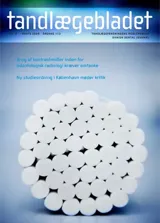Ultralydundersøkelser i hode og halsregionen
Tannleger bør ha et visst kjennskap til ultralyd- diagnostikk i hode og halsregionen og hvordan ul- tralydundersøkelser i dag brukes som veiledning ved forskjellige typer inngrep. En ultralydundersøkelse er en ikke-invasiv prosedyre, der man benytter lydbølger fram for ioniserende stråling. Formålet med artikke- len er å gi et aktuelt sammendrag av hvordan ultra- lydundersøkelser brukes i diagnostikk av tilstander i spyttkjertler og lymfekjertler. Artikkelen vil også berøre hvordan ultralydveiledning brukes i forbindelse med nålebiopsier, injeksjonsbehandling og kirurgisk behandling. Ny forskning om intraorale ultralydundersøkelser innen diagnostikk av tenner og dentalveo- lært ben vil også bli presentert
Ultrasound in the oral and maxillofacial region: An ultrasound examination is a non-invasive, inexpensive and easily available examination, which does not include ionizing radiation for the patient. Therefore, it is in creasingly used by radiologists and surgeons in the diagnosis and localization of lesions and foreign bodies in the head and neck region. Ultrasonography has a high sensitivity with regard to the detection of salivary gland tumours, and is commonly used as a complementary examination in the diagnosis of metastatic lymph nodes in patients with squamous cell carcinomas of the head and neck. Patients with benign or malignant lesions in the head and neck are rare but may occur in general dental practice. The intention of this paper is to summarize how ultrasonography is used today in the diagnosis of lesions in the head and neck region, focusing on salivary glands and cervical lymph nodes. Ultrasound-guidance during fine-needle aspiration biopsies (FNAB), intraglandular injections and surgical procedures, as well as research on intraoral ultrasound examinations are discussed.


